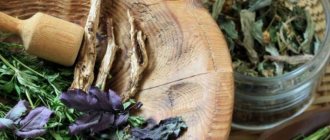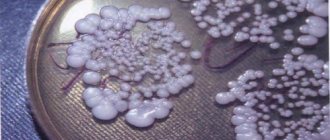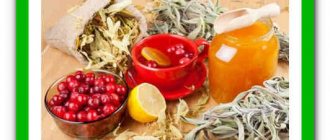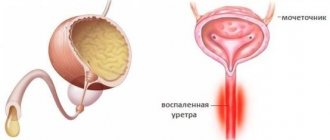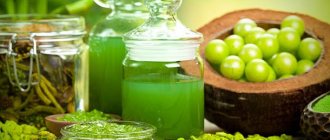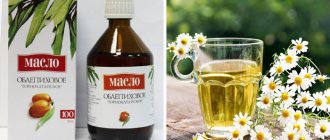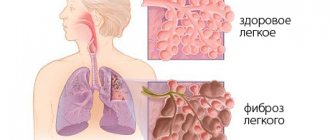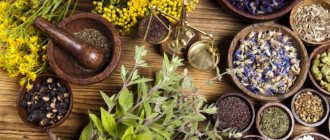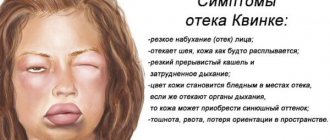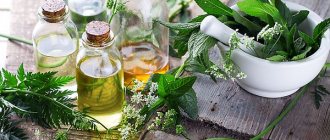Ascites - treatment of ascites with folk remedies and methods
Ascites, or, as it is popularly called, “abdominal dropsy”, “dropsy of the abdomen”, as a rule, is not an independent disease, but a consequence of other diseases that are quite serious and last a long time.
But it is extremely important to promptly recognize the disease ascites in order to prevent its progression and aggravation of the patient’s already poor condition. And start treating ascites as quickly as possible.
The clinical picture of ascites is as follows: it is the accumulation of fluid in the abdominal cavity associated with cardiovascular failure. in which fluid accumulates not only in the lower extremities, but also in the abdominal cavity, resulting in cirrhosis of the liver. toxic hepatitis. kidney diseases, cancer of internal organs.
In short, the disease ascites is a consequence of slagging of the whole body, when the organs of the excretory system cannot cope due to the resulting pathology. And fluid is released due to increased permeability of blood vessels.
With cardiovascular failure, blood stagnates in the veins and some of the blood is forced out through the walls of the blood vessels of the internal organs into the abdominal cavity. The fluid that accumulates in the abdominal cavity during ascites is largely similar in chemical composition to blood plasma.
By the way, during normal physiological activity of the body, when a person is completely healthy, a certain amount of such fluid may also be contained in sloping areas of the abdominal cavity, but its amount in such cases does not exceed 200 to 500 ml. And this is quite normal, and when its amount exceeds more than 2-3 liters, we can talk about ascites.
In patients with various diseases. complicated by ascites, to alleviate their suffering it is necessary to regularly pump out the accumulated fluid in the abdominal cavity.
After such pumping, the patient immediately feels better, since the excess load and volume of this fluid put a significant burden on the activity of the heart and internal organs, moreover, they compress the diaphragm, thereby making breathing difficult.
Of course, it is impossible to completely cure ascites unless the underlying cause is eliminated, that is, the diseases mentioned above. Usually, along with traditional methods of treating ascites and its causes, there are effective traditional methods of treating ascites, the recipes for which are given below:
Recipe 1. A patient with ascites should drink 1/3 cup of infusion twice a day, half an hour before meals, prepared from one tablespoon of bearberry herb per glass of boiling water and infused for half an hour.
Recipe 2. The following decoction effectively helps to treat ascites: pour one tablespoon of lingonberry leaves into a glass of water and boil for 15 minutes. The entire broth should be drunk in small sips throughout the day.
Recipe 3. When ascites is caused by cardiovascular failure, you need to use an infusion of birch leaves and buds: one tablespoon of buds or two tbsp. l. birch leaves pour half a liter of boiling water and leave for one hour. Strain and drink half a glass of infusion 3-4 times a day before meals.
Recipe 4. If swelling with ascites occurs due to liver disease. organs of the genitourinary system, infusions of parsley seeds and greens should be prepared:
- pour two teaspoons of parsley seeds into a glass of cooled boiled water and leave for ten hours in a tightly sealed container.
Drink one tablespoon of infusion half an hour before meals three times a day; This recipe is especially useful for patients with ascites who are advised to limit their fluid intake.
The recipes listed above increase diuresis (urine excretion), reduce the formation of edema and provide an anti-inflammatory effect, protecting the kidneys from overload.
Recipe 5. Among the traditional methods of treating ascites, a special place is occupied by the use of freshly squeezed juices of carrots, pumpkins, cucumbers, and viburnum mixed with honey. In order to ensure the active penetration of excess fluid into the intestines, it is recommended to give high enemas using an Esmarch mug and a hypertonic solution of table salt.
https://narodnaiamedicina.ru
Ascites is a painful condition in which excess fluid accumulates in the abdominal cavity. In cases where the volumes of accumulated fluid are small, then, usually, a person does not experience any pain, but when the accumulated fluid reaches a serious amount, then the patient experiences excruciating pain. Ascites, also known as abdominal hydrops, is mainly due to cirrhosis of the liver. Among other things, ascites can be a sign of heart disease and pancreatitis. and even cancer. A sedentary lifestyle and alcoholism contribute to the development of this disease, while alcoholism is the main cause of ascites throughout the world, therefore the best advice for preventing this disease is to lead a healthy lifestyle.
Garlic and its uses
This is the simplest and most accessible folk remedy that can be used to treat ascites. Garlic contains a substance called allicin, which has strong anti-inflammatory properties and helps relieve pain caused by ascites.
Its antibacterial properties also help kill germs that may be causing the infection that causes ascites. It is necessary to consume 4-5 raw garlic cloves daily to effectively fight ascites.
Improved cream for hydrocele
Mix equal amounts of calendula and baby cream. Then you should lubricate the testicles with this mixture and put gauze on top. And after all this, put on panties in the form of swimming trunks. In the sense that everything fits tightly. This way nothing sags, and this helps a lot.
About thirty days will pass, and everything will be fine with you. We really hope this helps you as much as it did me.
And here is another folk remedy for treating ascites, based on lotions. For half a liter of beer, take fifty grams of peas. Let it brew for one hour, after which it should be simmered a little over low heat. You will cook for a quarter of an hour. Then you need to let all this cool and apply it by moistening some kind of cloth, preferably linen. And so on until you get well.
Source: Newspaper Healthy Lifestyle, all-Ukrainian newspaper-healer “Granny”
Ascites is a secondary condition in which there is an accumulation of transudate or exudate in the peritoneal cavity. Symptoms of the disease are manifested in an increase in the size of the abdomen, pain, shortness of breath, a feeling of heaviness in the peritoneal area and other signs. In medicine, ascites is also called abdominal dropsy, which can accompany it.
Due to the fact that the main disease that causes ascites is widespread and occupies a leading position among the causes of mortality from gastrointestinal diseases, ascites itself in liver cirrhosis is not uncommon. Statistics indicate that ascites will occur in 50% of patients within 10 years of being diagnosed with liver cirrhosis.
Since ascites is not an independent disease, but one of the symptoms of various pathologies, the choice of dishes for a diet for ascites is determined by the characteristics of the disease. Diet for ascites is one of the means of treating the disease along with drug therapy. It significantly improves the patient’s quality of life in the first stages of ascites, although it does not replace taking medications.
Source
Dandelion in the treatment of ascites
Dandelion is an excellent folk remedy for the treatment of ascites. This plant helps improve digestion and helps reduce liver inflammation. As a result, this method is extremely effective for people who have acquired ascites due to liver disease. In addition, dandelion acts as a natural diuretic and helps remove excess fluid from the patient's body, thereby effectively helping to cure the disease. Make tea from dandelion grass with honey and drink it at least three times a day.
Treatment of ascites in boys
You should understand that a disease such as ascites cannot occur on its own, especially in men. Most often this is the result of some complex disease. This disease in most cases occurs due to disease of the liver, stomach, kidneys and other organs that are responsible for water metabolism in the body. Therefore, if you want to recover from this disease, then your treatment should be universal, or rather, it should be designed for the entire body. In traditional medicine there are various herbs that can affect the entire body. And we give an example of such a folk recipe.
You will need black currant leaves, gray jaundice and sage, chamomile. Take all this in proportions 1:1:1, after grinding it, for example, in a coffee grinder. Then you should pour one teaspoon with 200 grams of boiling water. Let it sit and then pass it through the mesh.
You should drink a quarter glass 4 times a day, that is, a glass a day. This should be treated for 31 days, followed by a seven-day break.
Burdock
This plant has been used for many centuries to treat a variety of diseases and maintain human health. Burdock is especially useful in the treatment of kidney and liver diseases, which are the main causes of ascites. Burdock roots have a strong anti-inflammatory effect and help relieve pain caused by ascites.
Burdock roots can simply be eaten raw, or you can make an herbal tea from the dried ingredient. Drinking two cups of this drink daily will help reduce swelling and pain.
https://natural-medic.ru
Ascites is a pathological accumulation of fluid in the abdominal cavity. Normally, the presence of a certain amount of serous fluid in the space between the intestinal loops and other abdominal organs allows them to move freely and unhindered to return to their original position. This fluid is produced and absorbed by the peritoneum, which looks like a thin membrane and envelops the abdominal organs, organizing its space.
In the process of various diseases, the established mechanism may be disrupted, fluid comes from other sources, its reabsorption does not occur, which leads to the development of ascites.
Successful treatment of ascites with folk remedies is possible provided that the underlying disease is treated and there is no resistant form. If ascites is a complication of end-stage cancer or cirrhosis of the liver, conservative treatment methods are ineffective.
Development of ascites in cancer
In oncology, ascites is a pathological accumulation of fluid in the peritoneum, which develops as a complication of cancerous tumors of the lungs, gastrointestinal tract, ovaries, breast and liver. This disease develops in the third and fourth stages. Ascites can cause the patient's death.
In practice, it turns out that 65% of patients remove fluid by using diuretics. Often, when treating ascites, abdominal paracentesis is performed, that is, puncture of the peritoneal cavity, which both alleviates the person’s condition and allows the fluid to be analyzed for leukocytes, total protein, and infection (culture, Gram method).
In oncology, treatment of abdominal ascites also involves chemotherapy. For example, the drug “Paclitaxel” is effective in testicular oncology, “Leucovorin” and “5-fluorouracil” are used in colon oncology.
Sometimes intracavitary treatment is prescribed, which consists of removing fluid from the abdominal cavity and administering Bleomycin.
Below are reviews of the treatment of abdominal ascites with folk remedies.
Reasons for the development of ascites
The most common cause is cirrhosis of the liver. Cirrhosis becomes the outcome of viral hepatitis (in particular C and B), alcoholism, and poisoning. Sometimes cirrhosis can develop spontaneously, for an unknown reason - primary biliary cirrhosis.
Lesions of the peritoneum: tumors, tuberculosis infection, metastases into the peritoneum of tumors of other organs.
Severe heart failure, which may be a consequence of myocardial infarction, myocarditis (inflammation of the heart muscle), congenital or acquired heart defects, development of cor pulmonale (due to lung diseases).
Chronic renal failure leads to a decrease in the amount of protein in the blood, its oncotic pressure decreases and plasma sweats through the walls of blood vessels into the surrounding tissues, and from there into the abdominal cavity. In addition, the exchange of electrolytes is disrupted.
Classification of pathology
This pathology is divided into three stages:
- Transit type. When infected, no more than four hundred milliliters of ascitic fluid accumulate in the patient’s body. To identify pathology at this stage, you will need to make a detailed diagnosis. The functioning of the organs will not be impaired.
- Moderate stage. Up to four liters of fluid accumulate in the peritoneum, the abdomen becomes rounded, and during a horizontal position, bulging of the lower area is detected. To detect fluid, simply tap on the abdominal area or perform a fluctuation. In a vertical position, breathing difficulties appear.
- Tense type. The most severe degree of the disease. Ten to fifteen liters of liquid accumulate, and sometimes more. In this regard, pressure on internal organs begins to increase, affecting their functionality. In such a situation, the patient needs urgent hospitalization.
Methods of traditional treatment of type 2 diabetes mellitus with recommendations
Only a qualified specialist can determine the current stage after detailed laboratory tests.
Manifestations of ascites
A patient with moderate ascites often has concomitant edema of the lower extremities, an expanded chest, inguinal, femoral, or umbilical hernia. He may be bothered by heartburn, shortness of breath, heaviness in the abdomen, and bowel movements. These symptoms of ascites are present provided that the pathology develops gradually over several weeks or months.
The abdomen with ascites is enlarged and has a different shape, depending on the stage. With moderate, non-strained ascites, the fluid-filled abdomen sags somewhat, and the veins of the abdominal wall are dilated. In the supine position, the stomach is spread out to the sides, soft (frog belly). A characteristic symptom of fluctuation is noted: with a slight push of the abdomen from the side, a response wave of fluid occurs in the other side.
With tense ascites, the abdomen is round, the skin on it is smooth, shiny, and tense. Possible thinning of the skin of the hernial umbilical sac and its rupture with the release of a certain amount of ascitic fluid. The patient may be in serious condition, with severe respiratory and cardiac failure, which is an indication for immediate laparocentesis.
Often, ascitic fluid becomes spontaneously infected, leading to peritonitis, with the development of a life-threatening condition. Infection is indicated by a sharp rise in body temperature and abdominal pain.
Diet therapy
The course of treatment includes following a strict diet (Table 1).
| Recommended Foods | Prohibited Products |
| lean meats: beef, rabbit, chicken, turkey fish greens: dill, parsley, spinach, lettuce vegetables low-fat cottage cheese grain crops fruits, only in the form of jelly and compotes | black strong tea coffee alcoholic drinks, marinades and dressings spices and hot dressings |
Main conditions:
- Limit the patient's intake of salt and carbohydrates.
- Avoid taking animal fat and reduce the amount of vegetable fat.
- Drink no more than one liter of water, less is possible.
- Food is boiled, stewed, steamed. A slow cooker or pressure cooker is ideal for this.
Diet therapy will allow the body to quickly recover and boost the human immune system.
Stages of ascites
- Transient ascites - the amount of fluid up to 400 ml is not visually determined. At this stage, ascites responds very well to treatment, which can only be limited to diet and adherence to the water-salt regime.
- Moderate - the stomach is soft; responds well to treatment with diuretics, albumin infusion, provided that the underlying disease is treated. Sometimes it becomes necessary to use laparocentesis (puncture of the abdominal cavity) and remove a small amount of fluid. If this procedure is abused, the next stage of ascites quickly develops, and secondary renal failure may occur.
- Tense (resistant) ascites - a large amount of fluid (up to 20 liters); resistant to treatment. Every day the patient loses less than 200 ml of fluid; a rapid increase in the volume of fluid in the abdominal cavity (patient weight, abdominal volume) is possible. To treat ascites at this stage, laparocentesis is almost always used as one of the methods of complex treatment.
- It should be noted that the stages of ascites can also be considered as its clinical variants, because depending on the course of the underlying disease, the rate of development of ascites may be different.
Treatment with folk remedies for abdominal ascites - causes of development and diet
Ascites in medicine has another term - dropsy in the abdominal cavity, which develops against the background of various diseases.
To avoid negative consequences, it is necessary to receive timely treatment. Treatment of abdominal ascites with folk remedies is quite effective if they are combined with medications.
The main thing in treatment is to act in accordance with the doctor’s recommendations.
Symptoms of ascites
Signs of pathology may differ; this is influenced by the advanced stage of the disease and the nature of its course.
At the first stage, the following symptoms are possible:
- chest expansion
- swelling of the legs
- formation of a hernia in the umbilical and groin area
- difficulty breathing
- burning
- constipation or disorders
- feeling of heaviness
Such symptoms can last from a week to four. In the second and third stages, symptoms change:
- the shape of the abdomen changes, it becomes round and swollen
- the skin of the abdomen is smooth, shiny, tense
- The hernia sac may rupture, releasing some ascitic fluid
- dyspnea
- heart failure
If the fluid infects internal organs, peritonitis can develop, which is life-threatening for the patient. At the first signs of ascites, you need to see a doctor and undergo an examination, this will allow you to provide assistance in a timely manner!
Sources of development
There are many factors causing this disease. This is often affected by chronic diseases or temporary pathologies.
The reasons are:
- Liver diseases
- Oncology
- Heart problems: rheumatism and failure
- Kidney diseases
- Diabetes
- Infection of the peritoneum
- Gynecological disorders
- Thyroid diseases
- lupus erythematosus
- Tuberculosis
- Non-infectious peritonitis
- Damage to the lymphatic system
- Rheumatoid arthritis
- Uremia
- Diseases of the gastrointestinal tract, such as pancreatitis
- Cirrhosis of the liver
- Consequences after using narcotic drugs
- Alcohol addiction
- Presence of tattoos
- Increased blood cholesterol levels
- Blood transfusion
- Hepatitis
- Living in an infected area
If you undergo examination and treat diseases on time, dropsy can be avoided.
Classification of pathology
This pathology is divided into three stages:
- Transit type. When infected, no more than four hundred milliliters of ascitic fluid accumulate in the patient’s body. To identify pathology at this stage, you will need to make a detailed diagnosis. The functioning of the organs will not be impaired.
- Moderate stage. Up to four liters of fluid accumulate in the peritoneum, the abdomen becomes rounded, and during a horizontal position, bulging of the lower area is detected. To detect fluid, simply tap on the abdominal area or perform a fluctuation. In a vertical position, breathing difficulties appear.
- Tense type. The most severe degree of the disease. Ten to fifteen liters of liquid accumulate, and sometimes more. In this regard, pressure on internal organs begins to increase, affecting their functionality. In such a situation, the patient needs urgent hospitalization.
Only a qualified specialist can determine the current stage after detailed laboratory tests.
Therapeutic therapy using non-traditional methods
Unconventional methods are often used in this matter. Treatment with plants is considered effective, but only when taken simultaneously with medications. Traditional medicine is considered a complementary and preventive technique, but not the main one. Many herbs help remove excess fluid, which is exactly what is needed during ascites.
about the most popular treatment methods:
Diuretic recipes
Diuretics include:
- Vitamin collection. For preparation use: black currants, rose hips, lingonberries, raspberry leaves. All ingredients are in equal quantities, the indicated berries are taken only dried. As a result, large four spoons of raw material are poured with 250 milligrams of boiling water, and cooked in a steam bath for about twenty minutes. Then the mixture is cooled and drunk every day in the morning and before bed.
- Apricot decoction. Since this product is rich in potassium, it is excellent for treating dropsy and is a good diuretic. You can eat the fruit in its pure form or prepare a decoction. To do this, you need to dry the apricot. For a liter of boiling water - a glass of apricots. The raw material is boiled for 40 minutes and drunk throughout the day as tea.
- Sweatshop tea. Fluid may be excreted through the urethra and sweat. To do this you should take: coltsfoot grass and linden inflorescences. Proportion: five grams of mixture (4 tablespoons) per 400 milligrams of water. The raw material is boiled for ten minutes and poured into a thermos. The drink is consumed hot to help you sweat. You should not drink more than 1 liter per day.
These recipes are safe and have virtually no contraindications.
Recipes for medicinal decoctions and tinctures
The most common means are described in Table 1.
| Main component | Cooking principle | Reception principle |
| green bean husk | Fifteen grams of husks are poured into a liter of liquid and cooked over low heat for ten minutes. The broth is infused for a quarter of an hour and filtered before use. | The first two hundred milligrams are drunk early in the morning, at four to five o’clock. The second dose is taken thirty minutes before breakfast. The third 200 ml is taken before lunch, 30 minutes before. The last dose is taken in the evening, preferably before 20:00. Take other herbal remedies and There should be no water on this day. Therapy lasts three days. |
| birch leaves, horsetail | Birch leaves (they should be dry) and horsetail are mixed in equal quantities. Then two tbsp. spoons of this mixture are placed in 250 milligrams of boiling water and infused for 30 minutes. | You need to drink the finished raw material immediately, between five and six o’clock in the morning. It is during this daily period that a person’s kidneys work more actively and become receptive. |
| parsley | Take a liter of water and 300 g of fresh parsley (you can take milk instead of water). The product is cooked on fire for 30 minutes. | It is necessary to take raw materials from the morning until 12 o’clock. There should be an equal interval between doses, from one hour to one and a half. |
Before use, it is important to check with a specialist whether these methods are suitable for your particular case.
Herbal baths
There are several options:
- Birch dry baths. Manipulation is carried out only in summer and spring. First you need to collect young birch leaves, put them in a basin, lightly tamping them down. Then the container is covered with polyethylene and left in the open sun for a couple of hours. Foliage should be prohibited. Now the patient sits down in this foliage and stays in it for an hour or two. If during the procedure the patient’s skin becomes numb, there is no need to panic, this is how it should be. This treatment is carried out 2-3 times a week until relief occurs.
- A decoction of white birch leaves is used. You can take dry or fresh foliage. Fresh leaves are less concentrated. Therefore, a larger proportion is applied. For seven to ten liters of boiling water you will need 100 grams of fresh leaves or 50 grams of dried leaves. The specified amount of water is poured into the bath, and using a boiler, the water is brought to a boil, and the leaves are poured into it. After the water temperature becomes comfortable, the patient needs to lie down in it for thirty minutes. During this time, the foliage gives up all its beneficial properties. If possible, you can prepare several buckets at once.
The dosage and period of therapy cannot be increased on your own!
Therapy for the treatment of ascites in children
Traditional recipes are not used to cure ascites in children. Urgent assistance must be provided before peritonitis occurs.
Doctors prescribe diuretics that speed up the removal of accumulated fluid. Hormonal medications are necessary to improve well-being. Vitamins are prescribed: ascorbic acid, folic acid, vitamins A and B.
In any case, the child is hospitalized, where he is under the constant supervision of doctors and medical staff.
Diet therapy
The course of treatment includes following a strict diet (Table 1).
| Recommended Foods | Prohibited Products |
| lean meats: beef, rabbit, chicken, turkey, fish and greens: dill, parsley, spinach, lettuce, vegetables, low-fat cottage cheese, grains, fruits, only in the form of jelly and compotes | black strong tea, coffee, alcoholic drinks, marinades and sunsets, spices and hot dressings |
Main conditions:
- Limit the patient's intake of salt and carbohydrates.
- Avoid taking animal fat and reduce the amount of vegetable fat.
- Drink no more than one liter of water, less is possible.
- Food is boiled, stewed, steamed. A slow cooker or pressure cooker is ideal for this.
Diet therapy will allow the body to quickly recover and boost the human immune system.
Reviews after using the traditional method
Alexey, 54 years old:
During my illness I decided to follow the advice. I boiled parsley in milk and ate it raw. I don’t know if this is an effective remedy, but nothing helped me.
Gregory, 48 years old:
I was diagnosed with an abdominal abscess. I spent the first time in the hospital to relieve the crisis, and then completed my treatment at home using traditional methods. I used the following recipes: parsley decoction, bean husk decoction and apricot. I have significantly improved my health, and I have been doing well for two years now, and I wish the same for you!
The program “Live Healthy” will tell us about this pathology:
So, there are many traditional medicine recipes for treating dropsy. Before taking any drug, you should make sure it is safe. The main thing is to carry out treatment on time and simultaneously with conservative measures.
Oct 16, 2018Violetta Lekar
Source: https://VseLekari.com/lechenie/lechenie-astsita-bryushnoj-polosti-narodnymi-sredstvami.html
Diet for ascites
Since ascites is not an independent disease, but a complication of the underlying disease, when prescribing a diet for ascites, the causes and mechanism of its occurrence should be taken into account. It is not always possible to compensate for protein deficiency by simply introducing it into the diet. For example, in liver cirrhosis, increasing protein intake can cause ammonia toxicity and coma. However, the need to replenish the amount of albumin in the blood is high. In this case, they resort to intravenous administration of albumin solutions. The retention of fluid in the intercellular spaces and its release from the vascular bed (that is, the formation of edema) is facilitated by table salt. In light of this, it is advisable to prescribe a salt-free diet. Fats in the diet of a patient with ascites should be a moderate or reduced amount, preferably of plant origin. The amount of carbohydrates should be limited, paying attention to their qualitative composition in the diet: complex carbohydrates (vegetables, fruits, cereals) are preferred. Fluid intake is limited to 750−1000 ml per day.
Of the recommended foods, common ones for ascites of various etiologies are: lean meat (in the amount specified by the doctor), fish, cottage cheese, cereals, vegetables, fruits, herbs. Food should be steamed and boiled in water without adding salt. Fruits should be consumed in the form of jelly, compotes, and as a filling for casseroles. Vegetables - boiled, baked, stewed. Be attentive to the list of vegetables and fruits in case of kidney failure: in this case, garlic, white and cauliflower cabbage, and spinach are prohibited. In this and other cases, radish, sorrel, legumes, and horseradish should be excluded.
In all cases of ascites, avoid alcohol, strong tea and coffee. Spices, seasonings, marinades, hot and sour sauces are also unacceptable.
Foods used in the treatment of ascites
Diet for ascites takes first place, because only proper nutrition and the exclusion of harmful foods from the diet improves the condition of the body. The diet helps to naturally cleanse the body and speed up metabolism. Dropsy of the abdomen has many causes, and treatment with home and folk recipes can improve the condition of the body.
This is interesting: Ascites in heart failure: causes, home treatment, prognosis
The inclusion of certain foods in the diet for ascites stimulates the removal of excess fluid from the abdominal cavity, and the pressure on the heart muscle decreases due to the normalization of fluid balance in the systemic and pulmonary circulation. So, what foods should you increase in your diet?
- Parsley. A popular representative of the product is a homemade antioxidant. The problem with eating parsley arises from the fact that you need to eat about 60-100 grams of greens per day. Therefore, homemade green smoothies come to the rescue, each of which can fit the daily requirement of greens into one mug of a healthy drink. There are a lot of folk recipes for ascites using large amounts of parsley;
- Pumpkin. It contains substances that can attract and bind molecules of free (excess) body fluid. In addition to removing excess fluid, waste and toxins are removed from the human body;
- Apricot. Used raw, dried, dried, boiled. Each fruit contains a lot of potassium, which stabilizes the heart rate, vitamins, minerals and beneficial microelements. Homemade apricots are best suited, since they contain more nutrients than store-bought ones;
Diet is the first thing a patient must follow when treating abdominal ascites. It is recommended to use home and folk recipes at the very beginning of the disease, because the sooner you start helping the body, the easier the course of the disease will be. It is better to eat homemade products, grown yourself or on a farm, as they are purest and healthiest.
Treatment of ascites with traditional methods
Always remember that you will be able to cure ascites only if you begin to treat the disease that caused it. As a rule, treatment of ascites with traditional methods is aimed at removing excess fluid from the bloodstream. In this case, fluid from the abdominal cavity tends to return to the vessels to replenish losses. For this purpose, diuretic decoctions and preparations are widely used. Most importantly, do not forget to replenish potassium losses by taking decoctions of fruits and vegetables, or eating them boiled or baked.
Recipe 1. Bean pods are an excellent diuretic.
To prepare one decoction you will need the husks of twelve to fifteen pods. Put it in a liter of water, boil for 10 minutes, leave for 20 minutes, strain.
Take the first portion of the decoction at 5 a.m. or earlier, 200 ml; the second - half an hour before breakfast, 200 ml; third - half an hour before lunch, 200 ml; the remaining volume is at your discretion, but no later than 20.00. Do not drink other liquids during treatment. If there is no effect within three days, change the medicine.
Recipe 2. Vitamin tea with a mild diuretic effect, as an addition to pharmacotherapy.
Dry, chop and mix an equal amount of components: lingonberry leaves, rose hips, currant leaves and raspberry leaves. Pour half a glass of the mixture into 250 ml of boiling water, boil for 10 minutes, and leave for 20 minutes with the lid closed. Strain.
Take the infusion after lunch instead of tea; if necessary, divide into two doses.
Recipe 3. Diuretic tea as a folk treatment for ascites.
Grind equal parts of hernia grass and bearberry leaves, air dry and mix. Place the finished mixture in a glass container with a tight lid.
Pour half a glass of the mixture with 250 ml of water, boil for 15 minutes, strain. Take tea on an empty stomach, half an hour before breakfast.
Recipe 4. Birch leaves and horsetail as a diuretic.
Mix the dried ingredients - birch leaves and horsetail grass - in equal proportions. Brew half a glass of the mixture with half a liter of boiling water every day, leave for 15 minutes. Strain and take as a diuretic. Drink this tea around 5 o'clock in the morning - at this time the kidneys are most active.
Recipe 5. Kidney tea as maintenance therapy for ascites.
Mix 3 parts each: juniper berries, rose hips, horsetail herb, linden blossom, elderberry.
Mix 1 part each: nettle, peppermint.
Combine both mixtures and mix thoroughly.
Pour half a glass of the mixture with 500 ml of water, boil for 20 minutes over low heat, strain.
Drink the decoction in the first half of the day, a third of a glass between meals.
Recipe 6. Apricot decoction as a source of potassium when using diuretics.
You can prepare a decoction from fresh or dried apricots. Place a glass of apricots in a liter of water and boil for 40 minutes. Drink 250−400 ml of decoction per day, the rest of the liquid should be diuretics.
Recipe 7. Parsley decoction to remove excess fluid from tissues.
Boil fresh parsley for half an hour in water: 300 grams of parsley - a liter of water. Strain the broth and take half a glass every hour in the first half of the day until the liquid runs out. Continue treatment for three days.
Recipe 8. Diaphoretic tea as an aid for removing fluid.
Chop and mix equal parts of linden blossom and coltsfoot herb. Pour half a glass of raw material into 400 ml of water and boil over low heat for 10 minutes. Strain the broth and drink well warm four times a day.
Be sure to control the amount of liquid you drink per day: it should not exceed one liter, taking into account all medicinal teas and decoctions.
Folk remedies for dropsy
- Black elderberry (root). It is recommended during the first stage of dropsy, especially because it relieves pain and cramping in the abdomen well, obviously for the reason that diuretic, cleansing and strengthening forces act together and actively at the root. The root is used in a decoction of 20.0-200.0, 1 tbsp. l. 3 times a day, as well as in the form of a tincture, which is prepared as follows: 1 part of the crushed root is poured with 10 parts of alcohol or vodka and left for 8 days, the dose of alcohol tincture is 25 drops, and vodka tincture is 40 drops 3 times a day. .
- American agave. Its fresh juice in combination with wormwood is used for incipient dropsy, when improvement of impaired digestion is required. 5 g, or 1 teaspoon of agave juice is combined with 1 g, or 20 drops of wormwood juice (and tincture in winter) and diluted with 1/2 liter of boiled water, or the same amount of agave is combined with 1 tbsp. l. wormwood decoction 5.0-300.0. Reception of this composition - 1 tbsp. l. 3 times a day.
- Elderberry is herbaceous, stinking (root). As it has a more active effect on the body, it is popularly used for all types of dropsy: abdominal (ascites), cardiac and renal; especially useful at the onset of the disease. It is better to use it in tincture (20.0) with alcohol, 15 drops, and if with vodka, then 30 drops 3 times a day. As a last resort, a decoction: 30 g of root per 1 liter of boiling water, take 1 glass 3 times a day. The decoction is often ignored due to its unpleasant odor. The plant is poisonous!
- Garlic and radish, used together (in half), are no less active means in the fight against dropsy; They use them like this: 1/2 tsp of juice of both. Take at the same time, with water, 2-3 times a day. To remove the unpleasant odor from garlic, chew parsley or calamus root. After 2 weeks the dropsy goes away.
- Gray jaundice (grass and seeds). As an active core, it should be considered first, especially in cases of hydrocele. Folk methods of using it (in the pre-medical period): decoction 10.0-200.0, 1 tsp, and in the form of tincture (20.0) 10 drops 3-4 times a day. Do not exceed the dose, as the remedy is pungent and the herb is poisonous! Do not keep medicinal raw materials for more than 6 months.
- Rosemary officinalis (herb and seeds). It is recommended in the form of a liqueur, which is sometimes on sale, for incipient dropsy, especially from a burning sensation inside. Dose: 1 glass 2 times a day. Can also be taken as a tincture (25.0) 25 drops 3 times a day. As a last resort - a decoction of 20.0-200.0, 1-2 tbsp. spoons 3 times a day 1/2 hour before meals,
- Gorse (herb). As a diuretic, cleansing and sedative, it is readily used by people in the fight against incipient dropsy and especially with dropsy of the abdomen. Most often used in a simple decoction 10.0-200.0 1 tbsp. spoon 3 times a day, but there is another option for use: 15 g of dried herb is poured into 500 g of cold water and boiled, evaporating up to 1/3 of the liquid. Take 2 tbsp. spoons every 2 hours. If it is not easy to take, you can reduce the dose to 1 spoon 3 times a day.
- Buckthorn brittle (berries or bark). The berries (with preliminary three-year airing) are recommended in powder form in a primitive dose “at the tip of a penknife,” or more precisely, 0.2-0.5 g 3 times a day. You can also take its bark (with the same three-year airing) in in the form of a decoction 20.0-200.0, 1 tsp. to the dining room. If as a tincture (30.0), then 25-40 drops 3 times a day, both. There is also a pharmaceutical liquid extract - 20-40 drops in the morning and evening. Follow the dosage!
- May lily of the valley (color). It is not only a core, but also an intensifying diuresis (urination) and a cleansing agent, and therefore is recommended in this case as a decoction of flowers 15.0-200.0 2 tsp. 3 times a day, or in the form of a tincture (15.0) 15 drops 2-3 times a day, or, finally, in the form of fresh juice, which is preserved with 64% alcohol, and this will be more effective. The dose is the same as a tincture. The plant is poisonous!
- Horsetail (herb). As a cleanser it is equally beneficial for dropsy. It is used in a decoction of 25.0-100.0, which is infused for 20 minutes and taken 2-3 tbsp. l. 3 times a day. Horsetail is contraindicated for nephritis and nephrosonephritis.
- Wormwood, Chernobyl (root). As a cleansing and soothing agent, it is recommended for dropsy in a root decoction of 20.0-200.0, preferably thickened to half, 1-2 tsp. 3 times a day.
- Panzeria woolly, motherwort white-tomentose (grass). Diuretic and sedative, used for dropsy (especially in Hungary) in a decoction of 10.0-200.0, 1 tbsp. l. or in tincture (25.0) 30-40 drops; both 3 times a day.
- Fumerica officinalis (herb). A stimulating and strengthening agent, for painfully debilitating dropsy, it is used as an additive in the form of a decoction 15.0-300.0, 1 tbsp. l. 3 times a day. In the form of tincture (25.0) – 30 drops or fresh juice with the same dosage. Canned with 25-30% alcohol.
- Gray blackberry (color and leaves). Cleansing and partly anti-inflammatory, popularly used internally as a decoction of 20.0-200.0 1/2 cup 3-4 times a day.
- Sweet clover (herb). A good softening and absorbent agent, auxiliary to the main remedies for dropsy, and can be used independently as a decoction 20.0-200.0 1 tbsp. l. 3 times a day.
- Seed oats (grain). As a decoction (with honey) 20.0-200.0 orally for all stages of dropsy, and its straw - externally as a compress or abdominal wrap (50 or 100 g per bucket) for abdominal dropsy (ascites).
- Budra ivy (grass). Used independently as an expectorant and partly as an anti-inflammatory agent in a decoction of 5.0-200.0, 2-3 tbsp. l. 3 times a day. Tincture (15.0) 15 drops is also used. More effective is juice (canned with 30-35% alcohol) 15-20 drops 3-4 times a day.
- White birch (buds and leaves). See below - chronic abdominal dropsy (ascites) and renal dropsy.
- Corn (columns with stigmas - “hair”). A soothing, anti-inflammatory and absorbent stone and sand product is a good remedy. Decoction 10.0-200.0, 1 tbsp. l. every 3 hours; pharmaceutical extract 20.0, 20-30 drops 2-3 times a day before meals.
- Note. Stigmas - “hairs” are suitable for consumption if they have not been in dampness, otherwise they lose their healing properties.
- Bearberry (leaves). As a diuretic and anti-inflammatory agent, it is recommended for dropsy in a decoction of 10.0-200.0, 1/2 cup 3 times a day.
- Calamus (rhizome). As a tonic it is useful for dropsy and is used in a decoction of 15.0-200.0, 1 tbsp. l. 3 times a day; You can also use it in powder, 0.2-0.5 g, on the tip of a knife 3 times a day, but it is most convenient in the form of a tincture (20.0) 20 drops 3 times a day before meals.
- Scots pine (buds). Freshly prepared decoction 10.0-200.0 inhale the vapor for 15 minutes several times a day. This is a potent diuretic.
- Cornflower. Infusion of cornflower flowers. Brew 1-2 teaspoons of flowers with a glass of boiling water, strain. Drink 1/4 cup 3 times a day 15 minutes before meals.
- Air. Boil 15 g of calamus roots for 15 minutes in 600 ml of water and take 100 ml 3 times a day half an hour before meals. Or infuse 50 g of roots in 0.5 liters of vodka. Take 1 teaspoon 3 times a day half an hour before meals.
- Chicory. Take 50-70 ml 3 times a day a decoction of 15 g of wild chicory in a glass of water. The decoction must be prepared fresh daily.
- Melissa. Take a tablespoon 3 times a day of a decoction of 15 g of lemon balm in a glass of water. Use tincture of 25 g per glass of vodka, 15 drops 3 times a day.
- Hawthorn. Take hawthorn tincture 15-20 drops in a glass of water 3 times a day after meals. The tincture is prepared from 1 part of hawthorn flowers and 10 parts of alcohol, infused for a week.
- Horseradish. It is recommended to take horseradish in the form of a paste with the addition of lemon juice, a teaspoon twice a day, on an empty stomach: a mixture of the juice of two or three lemons and 150 grams of horseradish.
Prevention of ascites
Prevention of liver diseases - hepatitis, alcoholic cirrhosis, intoxication - is the main link in the prevention of ascites. Once a year you should be tested for the presence of antibodies to the hepatitis C and B virus, especially if you do not have a regular sexual partner, work in the medical field, are a blood donor, or have undergone surgery.
Alcohol abuse, a vague concept for the average person, leads to liver failure and cirrhosis, the symptom of which is ascites. It is enough to know that drinking a bottle of beer every day for an average of two years is a sufficient dose for the development of these consequences.
Timely treatment of heart failure prevents the development of ascites. A person who has survived a heart attack is required to take maintenance medications for the rest of his life - only this will prevent complications, and in particular, ascites.
https://leshim-sami.ru
Treatment of dropsy of the hands and feet with drugs and medicines
IMPORTANT: They treat, first of all, not the dropsy itself, but the disease, if one caused it.
Therapy will be prescribed by the appropriate medical specialist. At the same time, measures are taken to reduce swelling. The patient is shown a special regimen:
- Depending on the case, physical rest or physical therapy is prescribed.
- Sometimes the patient is indicated for therapeutic drainage massage.
- The patient's therapeutic diet involves limiting water consumption.
Medicine for dropsy of hands and feet: Heparin ointment.
Dropsy caused by impaired blood flow is treated with ointments, creams and gels - phlebotonics. Heparin ointment, Troxavasin, Lyoton, Detralex are considered the most effective. Blood thinning drugs are prescribed internally - Aspecard, Cardiomagnyl, Lospiril.
How to treat abdominal ascites at home?
Without treating the pathology that caused the formation of ascites, no progress will be achieved, since the effusion will accumulate again. Therefore, drug therapy is first prescribed to treat liver disease, and only then traditional and home treatment methods are used. Treatment is possible in a hospital or at home, provided the patient is in good health. Traditional recipes and home remedies can be harmful if a person is prone to allergic reactions.
Bean pods
A decoction is prepared from the husks of bean pods, which is a mild diuretic. According to folk recipes, use the husks of 12 pods and boil for at least 10 minutes in one liter of clean water. Then filter and take one glass 20-30 minutes before breakfast.
Diuretic tea
A long-known folk remedy for edema, it has been used by patients for decades. It has a mild urinary and hypotensive effect. Able to tone the body, improving performance and alertness. It is used as a home remedy for ascites and cirrhosis, by improving the functioning of liver cells with constant use. For preparation, you will need the leaves of hernia vulgaris and bearberry in a ratio of one to one. They are boiled in one glass of water for about 10-15 minutes and drunk in the morning before meals.
Herbal diuretic decoction
The folk remedy is used in case of an increase in the amount of effusion in the abdomen and severe edema, since the remedy has a strong diuretic effect and reduces blood pressure. To do this, take birch leaves and horsetail and boil them in equal proportions in 1 glass of water. It is not recommended to take the whole decoction at once; it is divided in half and drunk in the morning before breakfast, being sure to monitor blood pressure and general well-being, since with therapy at home it is very easy not to notice the beginning of a deterioration in a person’s condition, attributing everything to fatigue and drowsiness.
Apricot decoction
Perfectly removes excess moisture from fabrics. Most often, a rich decoction is made from 200-300 grams of apricots per liter of water. Cook for about 15 minutes without using sweeteners. Take one glass in the morning, and if a positive result is noticeable in the form of a decrease in ascites, gradually increase the dosage to 400 milliliters per day, but only after the permission of the attending physician, since the traditional diet for such a disease excludes the consumption of large amounts of liquid.
Parsley decoction
An excellent antioxidant that can remove toxins and breakdown products from liver cells. Together with toxins, it removes excess effusion from the abdominal cavity, so parsley for ascites and home treatment is prescribed by a nutritionist without exception to all patients. For the recipe, use 250 grams of fresh parsley and brew for at least 20 minutes in a liter of water. Strain and drink 100 ml every hour in the morning.
Linden tea and mother and stepmother
Also quite a famous home diuretic. For brewing, use 20 grams of dried flowers in equal proportions and brew in 500 milliliters of boiling water, then cook for at least 50 minutes. The tea is taken in courses of 2 weeks, drinking three glasses of 100 ml of tea during the day.
Birch wraps
Helps cope with severe swelling in tissues. A universal home remedy. To do this, you need to take 100 ml of the decoction in one bucket of clean and warm water, soak a clean cotton cloth with it and wrap it around the patient, starting from the chest and ending with the feet. The person should be laid down and wrapped in a warm blanket. Remove the wrap after an hour and a half and do not allow the body to cool down - the person must remain warm.
Oat straw infusion
Only fresh, homemade straw is used, at the rate of 50 grams per liter of cold water. The infusion should be left for 2-3 days in a cool place. After which, it is filtered and taken by the patient in small portions (up to 150 milliliters). Most often, the folk recipe is used in villages and villages, since in a big city it is extremely difficult to get homemade straw.
Infusion of cherry stems
For ascites, the infusion is taken in courses of 7 days, then take a week's break and repeat again. For infusion, pour boiling water (one and a half liters of water) into 1-2 tablespoons of dry cherry stalks. Allow to cool and set for at least 4 hours. After straining, drink 100 milliliters, at least 3 times a day. This is a proven folk recipe that has helped more than one patient with home treatment.
Corn silk
4 teaspoons are poured with boiling water in a volume of 300 ml, infused and drunk within 2 days. After which a new decoction is prepared. It is useful for clear main symptoms of ascites and other methods of home and traditional medicine that do not work well.
Treatment of dropsy of the hands and feet with folk remedies: recipes
After doctor's approval, swelling of the limbs can be treated with juices.
IMPORTANT: Juicing is carried out exclusively with fresh fruit and vegetable juices with a pulp content of up to 10 percent. Even after several hours of storage in the refrigerator, juices lose most of their medicinal properties. Canned and packaged juices from stores are not suitable.
The recommended dose of juices is up to 600 ml per day; if you can’t drink that much, you don’t need to force yourself. Dropsy is treated with juices:
- cucumber (100 ml pure, add it to apple, carrot, beetroot)
- celery (also up to 100 ml per day)
- pumpkins
- carrots
- beets
- apples
Folk remedy for dropsy: juices.
You can make drainage baths for your hands and feet. Herbs are brewed for them: chamomile, aromatic rush, figs, clover, dubrovnik. Swollen limbs are also carefully rubbed with alcohol tincture of Kalanchoe.
Folk remedy for dropsy: viburnum with honey.
IMPORTANT: As a folk remedy for dropsy, you can use a vitamin mixture of viburnum berries, viburnum juice and honey.
VIDEO: Get rid of leg swelling in 5 minutes
Source
Regardless of the cause of dropsy, patients are advised to adhere to a vegetarian diet; it is very useful to eat raw cabbage, eggplant, cucumbers, honey with lemon, parsley, parsnips, watercress, and pumpkin. Instead of tea, it is recommended to drink a decoction made from watermelon rinds. Therapy for dropsy must begin with treatment of the organ whose disease caused the formation of edema, while salt and liquid intake should be minimized, and diuretics are useful as drug therapy.
Treatment of dropsy with plant juices
Black radish. For the treatment of dropsy, traditional medicine recommends drinking black radish juice with honey, gradually increasing the volume of the drug taken per day, from 1/3 glass per day to two glasses per day, dividing the daily dose into several doses.
Onion. To prepare onion juice, you need to take a couple of onions the night before, cut them into slices, and cover them with sugar. In the morning you should drink two tablespoons of freshly squeezed juice.
Pumpkin. When treating dropsy with folk remedies, it is recommended to drink half a glass of pumpkin juice per day.
Treatment of dropsy with elderberry and grapes
Elder. In the initial stages of the disease, ingesting a decoction of black elderberry bark helps. To prepare the drug, young shoots of the plant are used. Finely chopped plant bark in an amount of 6–8 g is brewed with a couple of glasses of boiling water and left in the oven for 5–6 hours. The decoction is taken half a glass up to six times a day.
In order to prepare a traditional medicine recipe for the treatment of dropsy, you can also use elderberry root, which is infused with vodka. The dose of this drug is selected individually, usually starting with a small amount of tincture, gradually increasing the volume of the drug.
Grape. Fresh grapes are good for dropsy. Up to ten berries of this plant should be eaten in the morning on an empty stomach, after which nothing should be eaten for as long as possible. Such treatment must be continued for a long time.
Treatment of dropsy with parsley and watercress
Recipe 1. Fresh parsley (half a kilogram) is poured with a liter of milk. The container with the drug is placed in the oven, where the milk simmers for 3–4 hours. When preparing the preparation, make sure that the milk does not boil, and after reducing the volume of liquid by half, remove the container from the oven and filter the contents. A decoction of parsley in milk is taken 1–2 tablespoons every hour during the day. It is recommended to eat as much watercress as possible throughout the course of treatment.
